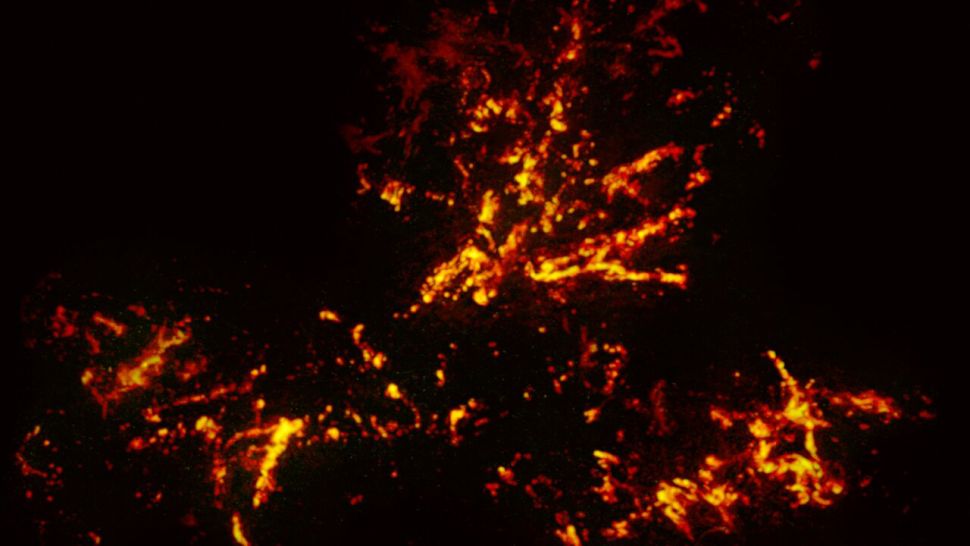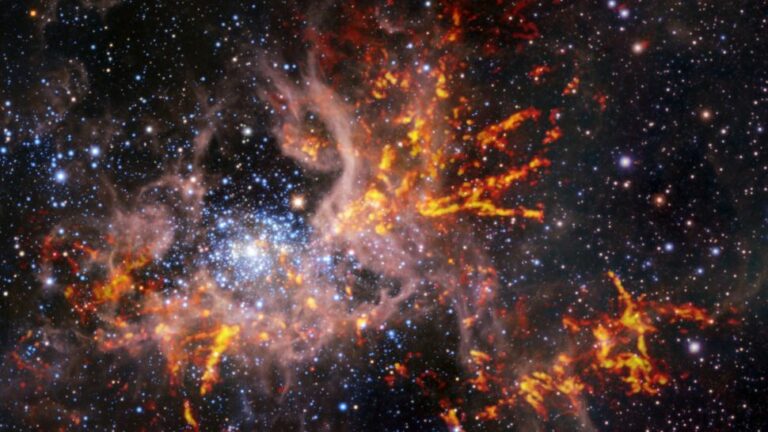Astronomers capture the cosmic web’s star-birthing activity. Insect Nebula
A recent image of 30 Doradus, also known as the Tarantula Nebula, shows thin spider-web-like strands of gas that reveal a dramatic struggle between gravity and stellar energy. This image may help astronomers understand how massive stars shaped this region of star formation and why stars keep forming there.
Atacama Large Millimeter/submillimeter Array data were used to create the high-resolution image of the Tarantula Nebula, which is 170,000 light-years away from Earth (ALMA). One of the most brilliant star-forming areas in our galaxy’s backyard, the Tarantula Nebula is situated in the Large Magellanic Cloud, a satellite galaxy of the Milky Way. In terms of producing new stars, it is also one among the most prolific; some of these stars have masses greater than 150 times that of the sun. A stellar nursery at the center of the Large Magellanic Cloud has produced 800,000 stars, half of which are hot, young, and massive stars.
The nebula has another distinctive characteristic that makes it an attractive potential for scientific study. This makes it a top target for academics who wish to study star formation.
Guido De Marchi, an ESA scientist and co-author of a paper describing the work, said in a statement, “What makes 30 Doradus unique is that it is close enough for us to study in detail how stars are forming, yet its properties are similar to those found in very distant galaxies when the Universe was young. We can examine how stars formed 10 billion years ago, when the majority of stars were born, thanks to 30 Doradus.
The battle to birth more massive stars
The energy produced by its massive population of stars and gravity, which works to draw gas clouds together to form stars while also tearing them into strand-like shards, are responsible for the “push and pull” that astronomers witnessed.
According to a press release from the European Southern Observatory (ESO), Tony Wong, an astronomy professor at the University of Illinois at Urbana-Champaign, “These fragments may be the remnants of once-larger clouds that have been shredded by the enormous energy being released by young and massive stars, a process dubbed feedback” .
The results also demonstrated that gravity is still forming huge stars and sculpting the nebula, which is 170,000 light-years from Earth and close to the Milky Way, despite strong stellar feedback.
This deviates from the prior consensus on these star-forming areas, which held that the feedback should disturb thin strands of gas like those in the Tarantula Nebula too much for gravity to be able to draw them together and generate new stars.
“Our results show that gravity may have a large impact and lead to a continuation of star formation even in the presence of very strong feedback,” Wong concluded.
Observing the Tarantula’s Web clump by clump

It seems sense that the Tarantula Nebula has been extensively researched given its characteristics. In contrast to earlier studies, which mainly concentrated on the nebula’s core, which had the densest gas and, hence, the fastest star formation, astronomers now know that stars are also forming in the nebula’s other areas. Rather than concentrating on the Tarantula Nebula’s core, their team gathered high-resolution data over a broad swath of the nebula. They then divided the nebula into clumps with this broad perspective in mind, which showed an unexpected pattern.
In a statement to the National Radio Astronomy Observatory (NRAO), Wong stated, “We used to conceive of interstellar gas clouds as puffy or roundish structures, but it’s becoming evident that they are string-like or filamentary.” “We found that the densest clumps are not randomly distributed but are highly ordered along these filaments when we separated the cloud into clumps to quantify variations in density.”
The astronomers were able to study the vast, frigid gas clouds in the Tarantula Nebula that collapse to produce young stars by concentrating on the light emitted by carbon monoxide gas. Additionally, they saw how these gas clouds changed as a result of the massive energy released by those nascent stars.
The regions of the cloud that are closest to the young, big stars should exhibit the most obvious effects of gravity being overpowered by feedback, according to Wong. Instead, we discovered that gravity is still significant in these feedback-exposed regions, at least for suitably thick portions of the cloud.
A composite image demonstrating the extent of its gas clouds and their distinctive web-like shape is produced by superimposing the data gathered by ALMA with an infrared image of the Tarantula Nebula showing bright stars and glowing hot gas from the Very Large Telescope and from the Infrared Survey Telescope for Astronomy (VISTA).
The research is still in its early stages, but the team’s results provide some insight into how gravity influences star-forming areas. We are making this incredible data set publicly available to inspire other academics to carry out fresh study since there is still so much more to be done with it, Wong said.
Future research will concentrate on the variations between the Milky Way and the Tarantula Nebula, such as the rates of star creation. While our galaxy generates stars gradually, the Tarantula Nebula does so in “boom and bust” cycles.
The research on the Tarantula Nebula was presented at the 240th meeting of the American Astronomical Society (AAS) in Pasadena, California, on June 15. The findings are also presented in a paper in The Astrophysical Journal.
Do not forget to share your opinion with us to provide you with the best posts !




0 Comments